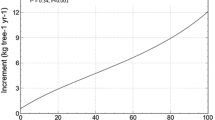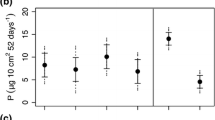Abstract
Forest growth is important both economically (yielding billions of dollars of annual revenues) and ecologically (with respect to ecosystem health and global carbon budgets). The growth of all forests follows a predictable general trend with age. In young forests, it accelerates as canopies develop; it then declines substantially soon after full canopy leaf area is reached. The classic explanation for the decline in growth invoked the increasing respiration costs required to sustain the larger masses of wood characteristic of older forests. Direct measurements of respiration have largely refuted this hypothesis, and recent work has focused on stand-level rates of resource supply, resource use, and growth. We developed and tested a hypothesis at the scale of individual trees (in relation to stand structure) to explain this declining stand-level rate of stem growth. According to our hypothesis, changes in stand structure allow dominant trees to sustain high rates of growth by increasing their acquisition of resources and using these resources efficiently (defined as stem growth per unit of resource used); smaller, nondominant trees grow more slowly as a result of their more limited acquisition of resources and a reduced rate of growth per unit of resource acquired. In combination, these two trends reduce overall stand growth. We tested this hypothesis by comparing growth, growth per unit of leaf area, and variation among trees within plots in two series of plantations of Eucalyptus in Brazil and by estimating individual-tree rates of growth and use of light, water, and nutrients in a plantation of Eucalyptus saligna in Hawaii. Our results supported the individual-tree hypothesis. We conclude that part of the universal age-related decline in forest growth derives from competition-related changes in stand structure and the resource-use efficiencies of individual trees.
Similar content being viewed by others
Author information
Authors and Affiliations
Additional information
Received 19 February 2001; accepted 19 June 2001.
Rights and permissions
About this article
Cite this article
Binkley, D., Stape, J., Ryan, M. et al. Age-related Decline in Forest Ecosystem Growth: An Individual-Tree, Stand-Structure Hypothesis. Ecosystems 5, 58–67 (2002). https://doi.org/10.1007/s10021-001-0055-7
Issue Date:
DOI: https://doi.org/10.1007/s10021-001-0055-7




